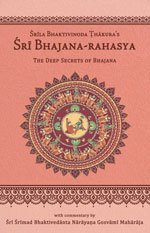Bhajana-Rahasya
by Srila Bhaktivinoda Thakura Mahasaya | 2010 | 123,965 words
The Bhajana-rahasya Text 15, English translation, including commentary (vritti). The Bhajana-rahasya is a compilation of verses describing the mercy of the eight pairs of names (Yugala-nama) of the Maha-mantra. This is text 15 belonging to the chapter “Shashtha-yama-sadhana (Sayam-kaliya-bhajana–bhava)” representing six dandas after dusk: approximately 6.00 p.m.–8.30 p.m.
Text 15
Attachment to beholding the beautiful form of the deity is described in Śrīmad-Bhāgavatam (10.23.22):
श्यामं हिरण्य-परिधिं वनमाल्य-बर्हधातु-प्रवाल-नट-वेशम् अनुव्रतांसे
विन्यस्त-हस्तम् इतरेण धुनानम् अब्जं कर्णोत्पलालक-कपोल-मुखाब्ज-हासम्śyāmaṃ hiraṇya-paridhiṃ vanamālya-barhadhātu-pravāla-naṭa-veśam anuvratāṃse
vinyasta-hastam itareṇa dhunānam abjaṃ karṇotpalālaka-kapola-mukhābja-hāsamHe is dark-complexioned like a fresh raincloud, and His yellow cloth, which defeats the splendour of gold, shimmers against His body. His head is decorated with a peacock feather, and every part of His body is ornamented with designs drawn with various coloured minerals. Sprigs of new leaves adorn His body, and around His neck is an enchanting five-coloured garland of forest flowers. Dressed in this way, He appears as a fresh, youthful, expert dancer. He rests one hand upon His sakhā’s shoulder and with the other He twirls a pastime lotus. His ears are decorated with earrings, curly locks of hair splash against His cheeks, and His lotus face blossoms with a gentle smile.
क्षणे-क्षणे देखे श्याम, हिरण्य-वलित
वनमाला-शिखि-पिञ्छ-धात्वादि-मण्डितkṣaṇe-kṣaṇe dekhe śyāma, hiraṇya-valita
vanamālā-śikhi-piñcha-dhātvādi-maṇḍitaनट-वेश, सङ्गी-स्कन्धे न्यस्त-पद्म-कर
कर्ण-भूषा-अलका-कपोल-स्मिताधरnaṭa-veśa, saṅgī-skandhe nyasta-padma-kara
karṇa-bhūṣā-alakā-kapola-smitādhara
Commentary: Bhajana-rahasya-vṛtti:
Upon the appearance of rati, the state of divine, passionate love known as anurāga arises in the sādhaka’s heart upon beholding the deity, and he experiences the splendour of Śrī Kṛṣṇa’s beauty as described in this verse. Śrī Kṛṣṇa’s head is decorated with a peacock feather crown, and His neck is beautified by a garland of flowers and leaves strung by the vraja-gopīs. His body is decorated with pictures made with aromatic minerals from Kāmyavana. Śrī Kṛṣṇa, who attracts everyone with His smiling face, puts His left arm around the shoulder of a priya-narma-sakhā, and His right hand twirls a pastime lotus. The ācāryas explain that His twirling the pastime lotus indicates that Kṛṣṇa’s heart dances like that lotus when He sees the devotees. Or, the devotees’ hearts dance like the lotus when they see Kṛṣṇa. Here, by His twirling of the lotus, Śrī Kṛṣṇa expresses the sentiment, “O fortunate brāhmaṇīs, I am holding your lotus-like hearts in My hand.” He implies, “Now that you have seen Me, your hearts are dancing like this lotus.” Or, “I will accept your hearts and make you My own.”
Śrī Kṛṣṇa entices all living entities to drink nectar by attract ing them with the sweetness of His beauty. By this mercy, many kinds of pastimes manifest within the sādhaka’s heart, and he experiences the happiness of relishing these pastimes.
